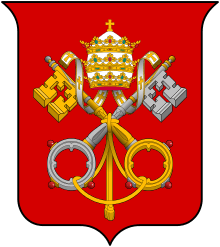Pope Callixtus I
| Pope Saint Callixtus I | |
|---|---|
 Pope Calixtus institutes the fasts | |
| Papacy began | c. 218 |
| Papacy ended | c. 223 |
| Predecessor | Zephyrinus |
| Successor | Urban I |
| Personal details | |
| Birth name | Callixtus or Callistus |
| Born |
??? ??? |
| Died |
223 ??? |
| Sainthood | |
| Feast day | 14 October |
| Patronage | Cemetery workers[1] |
| Other popes named Callixtus | |
Pope Callixtus I (died circa 223), also called Callistus I, was the bishop of Rome (according to Sextus Julius Africanus) from c. 218 to his death c. 223.[2] He lived during the reigns of the Roman Emperors Elagabalus and Alexander Severus. Eusebius and the Liberian catalogue gave him five years of episcopate (217-222). He was martyred for his Christian faith and is venerated as a saint by the Catholic Church.
Life
His contemporaries and enemies, Tertullian and Hippolytus of Rome the author of Philosophumena, relate that Callixtus, as a young slave, was put in charge of collected funds by his master Carpophorus, funds which were given as alms by other Christians for the care of widows and orphans; Callixtus lost the funds and fled from Rome, but was caught near Portus. According to the tale, Callixtus jumped overboard to avoid capture but was rescued and taken back to his master. He was released at the request of the creditors, who hoped he might be able to recover some of the money, but was rearrested for fighting in a synagogue when he tried to borrow money or collect debts from some Jews.[2]

Philosophumena claims that, denounced as a Christian, Callixtus was sentenced to work in the mines of Sardinia. He was released with other Christians at the request of Hyacinthus, a eunuch presbyter, who represented Marcia, the favourite mistress of Emperor Commodus. At this time his health was so weakened that his fellow Christians sent him to Antium to recuperate and he was given a pension by Pope Victor I.[2]
Callixtus was the deacon to whom Pope Zephyrinus entrusted the burial chambers along the Appian Way. In the third century, nine Bishops of Rome were interred in the Catacomb of Callixtus, in the part now called the Capella dei Papi. These catacombs were rediscovered by the archaeologist Giovanni Battista de Rossi in 1849.
When Callixtus followed Zephyrinus as Bishop of Rome, he started to admit into the church converts from sects or schisms who had not done penance.[3] Hippolytus found Callixtus's policy of extending forgiveness of sins to cover sexual transgressions shockingly lax and denounced him for allowing believers to regularize liaisons with their own slaves by recognizing them as valid marriages.[4][5] As a consequence also of doctrinal differences, Hippolytus was elected as a rival bishop of Rome, the first antipope.[6]
The Basilica di Santa Maria in Trastevere was a titulus of which Callixtus was the patron. In an apocryphal anecdote in the collection of imperial biographies called the Augustan History, the spot on which he had built an oratory was claimed by tavern keepers, but Alexander Severus decided that the worship of any god was better than a tavern, hence the structure's name. The 4th-century basilica of Ss Callixti et Iuliani was rebuilt in the 12th century by Pope Innocent II and rededicated to the Blessed Virgin Mary. The 8th-century Chiesa di San Callisto is close by, with its beginnings apparently as a shrine on the site of his martyrdom, which is attested in the 4th-century Depositio martyrum and so is likely to be historical.
Death
It is possible that Callixtus was martyred around 222 or 223, perhaps during a popular uprising, but the legend that he was thrown down a well has no historical foundation, though the church does contain an ancient well. According to the apocryphal Acts of Saint Callixtus, Asterius, a priest of Rome, recovered the body of Callixtus after it had been tossed into a well and buried Callixtus' body at night.[7] Asterius was arrested for this action by the prefect Alexander and then killed by being thrown off a bridge into the Tiber River.[7]
Callixtus was honoured as a martyr in Todi, Italy, on 14 August. He was buried in the cemetery of Calepodius on the Aurelian Way and his anniversary is given by the 4th-century Depositio Martirum and by subsequent martyrologies on 14 October. The Roman Catholic Church celebrates his optional memorial on 14 October. His relics were transferred in the 9th century to Santa Maria in Trastevere.[8]
References
- ↑ Jones, Tery M. "Pope Saint Callistus I". Saints.SQPN.com. Star Quest Publication Network. Retrieved 14 October 2010.
- ↑ 2.0 2.1 2.2 Chapman, John (1908). "Pope Callistus I" in The Catholic Encyclopedia. Vol. 3. New York: Robert Appleton Company.
- ↑ Philosophoumena IX.7
- ↑ Pagels, Elaine (1979). The Gnostic Gospels. Weidenfeld and Nicholson. p. 108.
- ↑ Hippolytus. Refutation of all heresies. Book 9 Ch. 7.
- ↑ "Saint Hippolytus of Rome". Encyclopedia Britannica.
- ↑ 7.0 7.1 Sabine Baring-Gould, The Lives of the Saints. Vol. 2. (J. Hodges, 1877). Digitized 6 June 2007. Page 506.
- ↑
 "Pope Callistus I". Catholic Encyclopedia. New York: Robert Appleton Company. 1913.
"Pope Callistus I". Catholic Encyclopedia. New York: Robert Appleton Company. 1913.
- Kelly, J. N. D. (2006). Oxford Dictionary of the Popes (2nd ed.). Oxford University Press. pp. 13–4. ISBN 0198614330.
External links
| Wikimedia Commons has media related to Pope Callixtus I. |
| Wikisource has original works written by or about: Callixtus I |
| Catholic Church titles | ||
|---|---|---|
| Preceded by Zephyrinus |
Bishop of Rome Pope 217–222 |
Succeeded by Urban I |
| ||||||||||||||||||||||||||||||||||||||||||||||||||||||||||||
| ||||||||||||||||||||||||||||||||||||||||||||||||||||||
|

